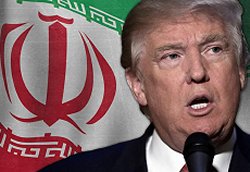
|
- Iran: Eight Prisoners Hanged on Drug Charges
- Daughter of late Iranian president jailed for ‘spreading lies’ - IRAN: Annual report on the death penalty 2016 - Taheri Facing the Death Penalty Again - Dedicated team seeking return of missing agent in Iran - Iran Arrests 2, Seizes Bibles During Catholic Crackdown
- Trump to welcome Netanyahu as Palestinians fear U.S. shift
- Details of Iran nuclear deal still secret as US-Tehran relations unravel - Will Trump's Next Iran Sanctions Target China's Banks? - Don’t ‘tear up’ the Iran deal. Let it fail on its own. - Iran Has Changed, But For The Worse - Iran nuclear deal ‘on life support,’ Priebus says
- Female Activist Criticizes Rouhani’s Failure to Protect Citizens
- Iran’s 1st female bodybuilder tells her story - Iranian lady becomes a Dollar Millionaire on Valentine’s Day - Two women arrested after being filmed riding motorbike in Iran - 43,000 Cases of Child Marriage in Iran - Woman Investigating Clinton Foundation Child Trafficking KILLED!
- Senior Senators, ex-US officials urge firm policy on Iran
- In backing Syria's Assad, Russia looks to outdo Iran - Six out of 10 People in France ‘Don’t Feel Safe Anywhere’ - The liberal narrative is in denial about Iran - Netanyahu urges Putin to block Iranian power corridor - Iran Poses ‘Greatest Long Term Threat’ To Mid-East Security |
Saturday 04 February 2012SYRIA, IRAN CRACKING
Imperial regimes can crack when they are driven out of their major foreign outposts. The fall of the Berlin Wall did not just signal the liberation of Eastern Europe from Moscow. It prefigured the collapse of the Soviet Union itself just two years later. The fall of Bashar al-Assad’s Syria could be similarly ominous for Iran. The alliance with Syria is the centerpiece of Iran’s expanding sphere of influence, a mini-Comintern that includes such clients as Iranian armed and directed Hezbollah, now the dominant power in Lebanon; and Hamas, which controls Gaza and threatens to take the rest of Palestine (the West Bank) from a feeble Fatah. Additionally, Iran exerts growing pressure on Afghanistan to the east and growing influence in Iraq to the west. Tehran has even extended its horizon to Latin America, as symbolized by President Mahmoud Ahmadinejad’s solidarity tour through Venezuela, Ecuador, Nicaragua and Cuba. Of all these clients, Syria is the most important. It’s the only Arab state openly allied with non-Arab Iran. This is significant because the Arabs see the Persians as having had centuries-old designs to dominate the Middle East. Indeed, Iranian arms and trainers, transshipped to Hezbollah through Syria, have given the Persians their first outpost on the Mediterranean in 2,300 years. But the Arab-Iranian divide is not just national/ethnic. It is sectarian. The Arabs are overwhelmingly Sunni. Iran is Shiite. The Arab states fear Shiite Iran infiltrating the Sunni homeland through (apart from Iraq) Hezbollah in Lebanon, and through Syria, run by Assad’s Alawites, a heterodox offshoot of Shiism. Which is why the fate of the Assad regime is geopolitically crucial. It is, of course, highly significant for reasons of democracy and human rights as well. Human rights – decency – is reason enough to do everything we can to bring down Assad. But strategic opportunity compounds the urgency. With its archipelago of clients anchored by Syria, Iran is today the greatest regional threat – to Saudi Arabia and the Gulf states terrified of Iranian nuclear hegemony; to traditional regimes menaced by Iranian jihadist subversion; to Israel, which the Islamic republic has pledged to annihilate; to America and the West, whom the mullahs have vowed to drive from the region. No surprise that the Arab League, many of whose members are no tenderhearted humanitarians, is pressing hard for Assad’s departure. His fall would deprive Iran of an intra-Arab staging area and sever its corridor to the Mediterranean. Syria would return to the Sunni fold. Hezbollah, Tehran’s agent in Lebanon, could be next, withering on the vine without Syrian support and Iranian materiel. And Hamas would revert to Egyptian patronage. At the end of this causal chain, Iran, shorn of key allies and already reeling from economic sanctions over its nuclear program, would be thrown back on its heels. The mullahs are already shaky enough to be making near-suicidal threats of blocking the Strait of Hormuz. The population they put down in the 2009 Green Revolution is still seething. The regime is particularly reviled by the young. It’s not just the Sunni Arabs lining up against Assad. Turkey, after a recent flirtation with a Syrian-Iranian-Turkish entente, has turned firmly against Assad, seeing an opportunity to extend its influence, as in Ottoman days, as protector/master of the Sunni Arabs. The alignment of forces suggests a unique opportunity for the West to help finish the job. How? First, a total boycott of Syria, beyond just oil and including a full arms embargo. Second, a flood of aid to the resistance (through Turkey, which harbors both rebel militias and the political opposition, or directly and clandestinely into Syria). Third, a Security Council resolution calling for the removal of the Assad regime. Russia, Assad’s last major outside ally, should be forced to either accede or incur the wrath of the Arab states with a veto. Force the issue. Draw bright lines. In diplomacy, one often has to choose between human rights and strategic advantage. This is a rare case where we can advance both – so long as we do not compromise with Russia or relent until Assad falls. Source: The San Diego Union-Tribune |






